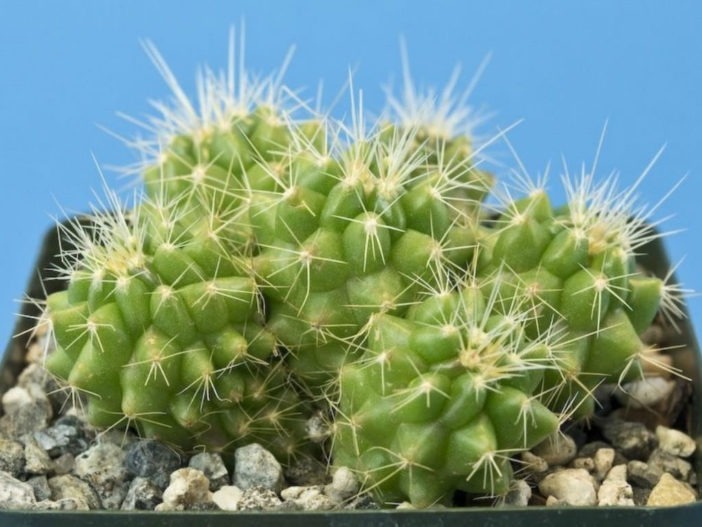The aptly named “Golden Barrel” or “Golden Ball” cactus (Echinocactus grusonii) rarely grows in its native place, but it is often grown as a houseplant. Sometimes it is used in the garden outdoors in arid climates, where the temperature never drops below 40 degrees Fahrenheit (zones 10 to 11). This cactus rarely blooms indoors, but it is possible if you simulate ideal growing conditions and the plant is at least 15 years old. When it blooms, the flowers appear in spring or summer.
It is called a barrel-shaped cactus because, as the name implies, at a young age they are almost perfectly round. They are beautiful, with evenly spaced rows of spikes on their deeply ribbed blades. As they grow, they often stretch out, so they have an oval rather than a round shape. As is the matter with most cacti, the secret to successful indoor growth is almost perfect drainage, not letting them dry.
This cactus can be quite a large plant when it is fully grown (up to 6 feet tall), and it costs hundreds of dollars to buy it this size. They grow slowly, so small 3-inch indoor specimens will remain manageable for many years before becoming too large.
- Botanical name Echinocactus grusonii
- Common name Golden Barrel Cactus, Golden Ball
- Plant type perennial, cactus
- mature size 3.5 ft. Height, width 2 feet
- Full Sun Exposure
- Soil type: well-drained soil or a mixture for cacti/succulents in pots
- Soil pH from 6.1 to 7.5 (slightly acidic to slightly alkaline)
- Flowering time Spring, Summer
- Flower Color Yellow
- Hardiness Zones Zones 10-11 (USDA)
- Homeland North America
Care of the Golden Barrel cactus
Echinocactus includes about six species of barrel-shaped cacti, including a golden variety native to Mexico and the southwestern United States. These are real desert plants that cannot tolerate stagnation of water during cultivation. Plant them in very well-drained soil or potting mix. When growing indoors, these plants need the brightest and sunniest place you have.

They can produce flowers, but usually they will not bloom until they reach a width of at least 6 centimeters, which can take about 15 years. The flowers are about two to three inches wide and grow at the top of the trunk for about two to six weeks in spring or summer.
The trick to getting a golden cactus to bloom is to make sure it is fully exposed to the sun during the growing season. It also needs a phosphorus-rich fertilizer at least once a month to stimulate flowering from April to September. In addition, a few months before the beginning of the growing season, refrain from watering. Simulated drought mimics its natural growth cycle in the wild. To stimulate flowering, water it once a week as it grows indoors. This plant needs well-drained soil, as waterlogged soil leads to root rot, which can lead to the pass away of the plant.
Light
The golden barrel cactus grows best in a sunny window, possibly with a southern exposure. Plants that don’t get enough sunlight will grow slowly and won’t thrive.
Water
Golden-barrel cacti are susceptible to root rot. From autumn to spring, water a little (once a month or two) and make sure that the soil is completely drained. Do not leave water in the container and do not leave it in the water.
In winter, simulate drought conditions without giving water. In early spring, water gradually, increasing watering to once a week in spring and summer, so that the water drains completely.

Bottom
Outside, this plant needs dry, very well-drained soil. A quick-drying soil mixture for cacti is ideal. If you use a regular peat-based mixture, add sand or additional perlite to improve drainage. Transplant the plant when the soil begins to break down. Stimulate drainage by adding a few inches of gravel or small pebbles to the bottom of the pot.
Fertilize
Feed these plants with low-nitrogen fertilizer every four weeks.
Temperature and humidity
While the plant prefers warm conditions, the cactus can tolerate temperatures up to 50 degrees Fahrenheit. It works best without moisture.
Varieties of “California barrel” (Ferocactus cylindraceus): also known as California barrel cactus, desert barrel or miner’s compass; a large variety with yellow flowers and downward-curved spikes.
“Fishhook cactus” (F. wislizenii): Also known as Arizona barrel cactus, candy barrel cactus or southwest barrel cactus; has brighter flowers than other types of barrel cacti.
“Blue barrel” (F. glaucescens): it is usually called a cactus with a blue barrel or a Texas blue barrel; it has blue-green stems and long-lasting lemon-yellow flowers.
“Colville’s keg” (F. emoryi): commonly known as Emory’s cactus, Sonora’s keg, traveler’s friend, or nail keg; has spikes that can turn gray or pale golden as the plant matures; flowers are yellow, orange, or burgundy.
Growing Golden Barrel Cactus From Seeds
Golden barrel cactus is usually propagated by seeds. To sow the cactus, plant the seeds shallowly in the cactus mixture and keep them warm and very slightly moist. A mature cactus will bloom in summer, and flowers will grow in wreaths around the top of the plant.

Barrel-shaped cacti can also sprout “puppies” at the base of the plant. Remove the soil around the baby plant, then cut it off from the mother plant with a sharp knife. Let the puppy sit for a day until a small corn forms at the cut-off site, then put it in a container filled with a coarse cactus mixture for potting soil. Water immediately, but limit watering until the new plant takes root itself.
Planting and transplanting Golden Barrel cactus into a pot
You need to transplant barrel cacti every few years. It is best to transplant at the beginning of the growing season or in summer. To transplant a cactus, make sure the soil is dry and carefully remove the plant from the pot, wearing thick leather gloves for safety. Remove old dirt from the roots and remove all rotten or dead roots in the process. Treat all cuts with a fungicide.
Place the plant in a new pot and fill with the pot mixture intended for cacti, distributing the roots as you transplant. Leave the plant dry for a week, then start watering lightly to reduce the risk of root rot.
Common ailmnts and pests
Problems with golden barrel cactus are rare, but sometimes they can be infected with mealybugs or scales. The best remedy is spraying with water and then applying insecticidal soap.




